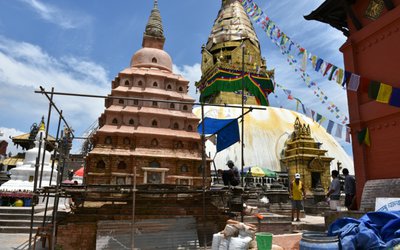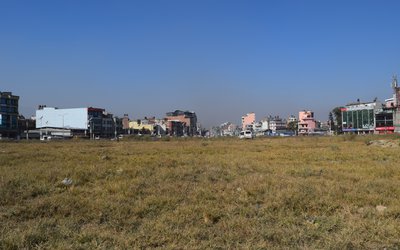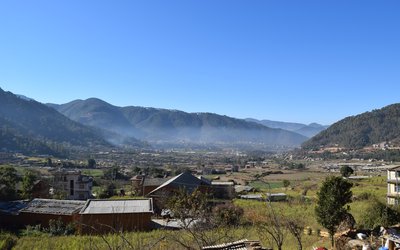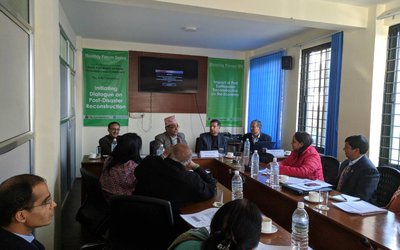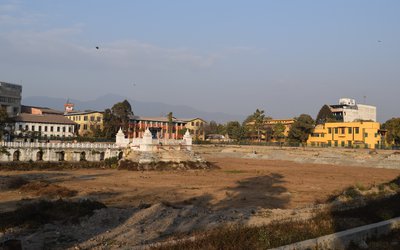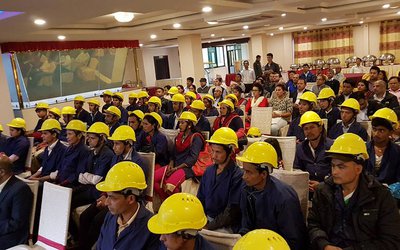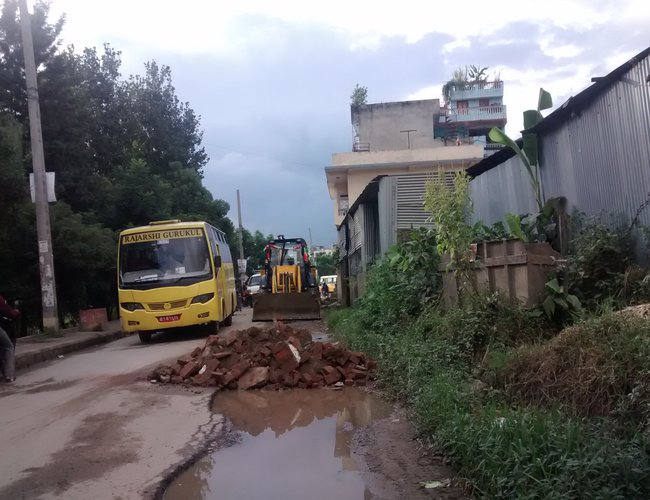
Thule Tamang, 34, a mini-truck driver of Ramechhap, carries two to three trips of debris from the core city area of Lalitpur every day. If his truck is loaded with soil and other reusable wastes, he contacts the petty contractors and sells them for a reasonable price, between Rs.2000,00 to 25,00.00, and unloads them where such materials are used, such as, for filling the low land. If his truck is loaded with pieces of bricks, cement plasters, glass and other materials, he dumps them in the open spaces, including the river banks.
“I have dumped almost 300 trips of waste materials in the bank of Manahara, Bagmati, other ravines and open spaces over the last two years,” said Tamang. “Since people have started to oppose unloading of such materials, we dump them after midnight,” said Tamang, who charged Rs. 2, 000.00 to 2500.00 per trip to carry the hazardous materials. Tamang said that he had been paying additional money to the owners if the materials are soil, sand, wood and unbroken bricks.
“Every day one or two mini trucks have been dumping the debris at river banks of Manahara near Sankhamool,” said Tamang.
As the pace of reconstruction intensifies, there is a rush for the people to clear the debris to prepare the ground for reconstruction. With no permanent landfill sites allocated to unload the earthquake debris, people are using open spaces and river banks for dumping the waste.
According to Nepal Reconstruction Authority, earthquakes fully damaged 4, 99,921 buildings and partially damaged 258655, with total damaged buildings reaching 758576 in number. According to an Environmental Baseline Study of the Post-Disaster situation, conducted under the aegis of the National Planning Commission during Dr. Amatya’s tenure as a member, the total estimate of rubble from fully and partially damaged buildings is 18.854 million cubic meter.
“There is a huge volume of wastes containing lead and mercury concentration in paints and tube lights. Total paints contained in damaged houses are estimated to be 2,007,732 liters in 31 districts. Out of this total paints used in three districts, Kathmandu Valley’s damaged houses are estimated have 725670 liters,” said Dr. Amatya. “Total lead content in the damaged houses required for safe disposal is 180.7 KG in 31 districts and there is 0.725 KG of total lead wastes in the damaged house rubbles in three districts of Kathmandu Valley. Similarly, total mercury content in the damaged buildings due to CFL bulbs for safe disposal is 5.72 KG in 31 districts. There are 1.451 such hazardous materials in three districts of Kathmandu Valley.”
With such a huge volume of rubble, there is the need of a large space for disposal. Although the government is planning to keep more open spaces for safety, the open spaces are vanishing under piles of rubble.
“Open spaces of Kathmandu Valley are under threat not only from illegal encroachment but also from the disposal of rubble,” said Kishore Thapa, former secretary of Ministry of Urban Development and expert on town planning.
Riverbanks of Lalitpur district are not the only places facing the problems of the waste dump. All the 31 earthquake-affected districts have been facing the challenges of properly managing the earthquake wastes.
Even at the heart of Kathmandu, at Tundikhel, almost 400 tons of debris of core areas of Kathmandu has been lying for almost three years. The debris consists of valuable broken heritage materials.
“In the presence of representatives of Kathmandu Metropolitan City, Nepal Army, and Nepal Police, we have already segregated large portions of wastes, recovering many valuable heritage materials. We will dispose of the remaining pieces of bricks and soil in proper places,” said Bhesh Narayan Dahal, Director General of Department of Archeology.
Solid Waste Management Act 2011 and Solid Waste Management Regulation have clear provisions forbidding the dumping of wastes in open spaces and other public places without permission -- such acts are subject to punishment.
The Act provides guidelines for a solid waste generation, collection, and disposal management. According to the act, the local bodies shall be responsible for the management of solid wastes and other wastes by construction and operation of infrastructure like transfer station, landfill site, processing plant, compost plant, biogas-plant and also a collection of waste, final disposal, and processing. It specifies all the requirements and corresponding institutional responsibilities to perform the activities.
Under the provisions of the act, rampant disposal of waste is a public offense with Rs.10,000.00 in fines and five years in prison. “Municipality and local authorities are fully empowered to punish those who dispose of the wastes with rampant recklessness,” said former executive director of Solid Waste Management Technical Support Centre (SWMTSC) Center Dr. Sumitara Amatya.
With a weak institutional mechanism for regulatory action, there is a rampant disposal of earthquake wastes in all the districts, including those in the Kathmandu Valley and other parts of the country.
As people are unaware about wastes segregation, the earthquake wastes, mixed with hazardous materials like glass, plastic, plasters, and pieces of cement and other lead-containing elements, including paint, plastic, and bulb, are disposed of in one place.
“Since act and regulation are there, municipalities and rural municipalities have to regulate the waste management. However, their institutional capacity is weak and they are unable to regulate the solid waste treatment and management,” said Dr. Amatya. “I don’t understand why the administration and police cannot take action?”
District Administration Office and police have been launching periodical operations to prevent haphazard disposal and they punished some individuals, too. However, many trucks are loaded with solid wastes to unload these in public places, such as, in front of the police post in Manahara River.
Local people hold the view that the truck drivers are dumping the wastes under the protection of the police. Police reject such accusations.
Alarming Situation
The situation is alarming. However, the municipal authorities of Kathmandu Valley have been taking hardly any initiative to make the necessary arrangements for disposal of the hazardous wastes. The central government is yet to take steps on this.
One glass dealer has a good experience to share. Following the earthquake, he incurred a heavy loss as almost three tons equivalent of his glassware got destroyed. When he went to Kathmandu Metropolitan City for help in its disposal, the municipal official suggested he dispose of it in some open space like Chovar. “I was shocked when a senior official told me to do this,” said a dealer on condition of anonymity.
As the government and municipalities are yet to allocate safe and proper landfill sites for earthquake debris, the earthquake wastes are dumped in open spaces, river banks, ravines, drainage systems, ponds and pits in the streets.
National Strategy
Prepared by Nepal government and UNEP, the Disaster Waste Management Strategy Policy, Strategy and Action Plan 2015, has proposed certain measures for earthquake waste management.
“Disaster-generated wastes can have a negative impact on all three pillars of sustainable development: social, economic and environment. Correct handling of the disaster waste management will positively influence the six essential elements of SDG, dignity, people, prosperity, planet, justice and partnership,” said the report. “Disaster waste resource recycling industry will be developed to produce the construction materials contributing to building resilient infrastructure,” said the report.
At a program organized by Japan International Cooperation Agency (JICA) last month, experts expressed deep concern at a stakeholders’ meeting on disaster waste management. “If we do not manage the disaster waste properly and scientifically, it will have a long-term environmental problem affecting human health,” said Mahesh Pradhan, program officer for Disaster Waste and Climate Change, UNEP/IETC.
For example, immediately after the earthquake, debris was collected at the bus park collection point and monuments’ artifacts were preserved in safe places like Tundikhel. However, people started piling the debris on the roadsides, low lands, private lands, and riverside afterward.
This situation is similar in all the affected districts, including Sindhupalchwok, Gorkha, Charikot, Dhading, and their headquarters.
Locals and people in the adjoining wards have collected the rubble to fill their low private lands. Also, some contractors collect the rubble and sell it to people who need these to fill their lowlands.
Due to lack of proper infrastructure, resources, policies, and guidelines on earthquake waste management, Nepal is now facing a large problem in dealing with the waste management issue. The recent earthquake accumulated over 3 million tons of disaster wastes, including chemical wastes, in Kathmandu Valley alone.
“Kathmandu Metropolitan has been doing its best to properly dispose of the earthquake wastes. With limited resources and knowledge, we cannot handle this entire disposal on our own,” Hariprabha Khagdki, deputy mayor of Kathmandu Metropolitan City told New Spotlight. “How can KMC alone handle such a big volume? We have the capacity to manage 1000 tons of waste and garbage daily.”
To prevent major health problems in the future, the government should take up disaster waste management seriously and immediately to protect the local environment and public health. Although Solid Waste Management Technical Support Centre (SWMTSC), a national governing body of Government of Nepal, is one of the major bodies concerned to deal with the solid waste issue, it is helpless because of the lack of resources.
There is the need to provide a proper institutional setup with proper coordination with respective authorities, equipping them with the knowledge base of people, staff, resources, manpower, efficient and appropriate equipment and prompt decision making.
Experts suggest that during the handling and demolishing period, there is the need to launch capacity building training to equip the manpower on demolishing the particular type of houses in particular settlements.
As recycled waste also generates money, there is the need to launch awareness programs to help the locals know how to get profits out of reusable and recyclable materials such as wood, brick, mud, and cement mix which are collected from the collapsed or demolished buildings.
Realizing the importance of debris management, National Reconstruction Authority has already taken earthquake waste management as part of the reconstruction. “NRA is now working with the local levels and other institutions involved in waste management on how to recycle, reuse and safely dispose of the earthquake wastes,” said Yam Lal Bhoosal, spokesperson for National Reconstruction Authority.
Unlike regular wastes, disaster wastes include large quantities of mixed wastes produced within a very short timeframe. Coordination is one of the key challenges at all levels of the government and amongst other stakeholders involved in waste management.
“Earthquake waste management should be given proper priority. It is unfortunate that it is not on the priority list,” said Dipendra Oli, legal officer of Solid Waste Management Technical Support Centre (SWMTSC).
Two and a half years after the earthquake, large dumps of disaster wastes are still lying here and there, creating immediate risks and long-term implications.
None of the existing legal provisions, including Solid Waste Management Act 2013, speaks specifically about the disaster waste management. Experts argue that a disaster waste management policy is needed to facilitate and coordinate safe and cost-effective removal, collection, recycling, and disposal of debris following a disaster and to mitigate any potential threat to the health, safety, and welfare of citizens and the environment.
Disaster wastes comprising bricks, sand, aggregates, steel, timber, CGI sheets and aluminum pieces are lying around in earthquake-hit areas. Even debris collected at Tundikhel is waiting for its proper disposal.
Experts argue that disaster waste can be converted into construction materials. Debris can be easily converted into interlocking bricks which can be used as primary building materials. A simple set-up with a crusher to convert debris into small particles, a mixer to mix small particles, soil and binder and an interlocking machine to produce interlocking bricks can produce such building materials. Using interlocking bricks can save up to 40 percent cost of building houses compared to conventional brick-and-cement houses.
“In Japan, we have been recycling the disaster wastes and reusing them in reconstruction,” said Masayuki Koiwa, senior specialist of Disaster Waste Management of Japan. “After visiting the sites and observing the wastes, I draw the conclusion that over ninety percent of earthquake wastes of Nepal can be recycled and reused in reconstruction. Only about 10 percent of waste needs a place for safe disposal.”
Due to the slow debris management and lack of effective ideas for this, it is one of the burning issues of post-earthquake Nepal. Non-metal wastes include bricks, concrete, reinforced concrete, wood, plastic, and glass. The toxic metal can easily be recycled and reused. As there is a lack of debris processing industry, Nepal is facing challenges to make the recycling applicable.
Hazardous Wastes
Due to lack of knowledge, people are dumping hazardous wastes randomly. The case of Dolakha district is a testimony.
According to a study made by SWMTSC and Ministry of Urban Development, the volume of paint and lead from damaged houses and building is estimated to be 3.176 million liters and 33 kilograms in Kathmandu Valley and 1.3 million liters and 116 kilograms in other 11 earthquake-hit districts respectively.
Other hazardous wastes include battery and mercury. Locals are directly exposed and there is a lack of proper protective measures and first aid for demolition workers and supervisors.
Although the time is gradually running out, the authorities are still changing things by proper chandelling and disposing of the wastes. One of the best ways is to recycle, reduce and reuse (3R) debris. As it shows, construction and demolition debris represent a large portion of earthquake disaster debris; they provide an excellent opportunity for recycling, reuse, and reduction.
In a city like Kathmandu, these can be used in the expansion of roads. Currently, many contractors are using it. However, it is without segregation. Experts hold the view that masonry materials, like brick and blocks, and concrete could be used in the landscaping industry. Timber and other wood products can be used in a variety of ways. Drywall can be recycled into new drywall, cement and agricultural uses. Metal is already typically recycled, therefore, options for metal recycling after a disaster is very promising.
As earthquake debris is mixed with hazardous items like paints, medicines, fertilizers, handling debris require cautious steps because most debris is mixed with hazardous items like paints, medicines, fertilizers, pesticides, among others. The segregation of wastes before dumping is also essential.
In the first place, wastes should be segregated manually for recycling, reusing and reconstructing purpose. The best way to handle that waste is to coordinate with local recyclers and local government and plan to manage wastes accordingly.
As the drivers like Tamang and other contractors demand huge money, quake-affected people of Lalitpur, Bhaktapur, and Kathmandu have to pay big amounts to the contractor to clear the debris of destroyed houses.
As there is no effort to monitor earthquake waste disposal, the waste collected by the contractor goes directly to the nearest dumping site without segregation. This will cause many other problems to humans, including skin, respiratory problems, water contamination with hazardous liquid coming from dumped waste and much more.
To save the people from hazards, what is required is segregation of the wastes and this should be made compulsory before sending it to the dumping site. Strict action should be taken against haphazard waste disposal in open spaces and river banks. However, this is what is lacking in earthquake waste management. Given the current state of earthquake waste management, serious impacts on environment and health of people are likely.
Waste Management Is Linked With Reconstruction: Oli
As management of earthquake debris is creating a lot of problems, Dipendra Oli, a legal officer with Solid Waste Management Technical Support Resource Center, spoke to NEW SPOTLIGHT on various issues. Excerpts:
How do you look at the earthquake waste management issue?
Earthquake waste can create a lot of environmental problems, particularly in the groundwater resources. Earthquake debris contains many hazardous wastes including lead, mercury, acid, and glass. Directly, the challenge is the issue of management. However, the hazard part is very alarming.
What needs to be done?
There is the need to properly manage the hazardous part and we have already told the government about this. The earthquake wastes have a serious impact on the total municipal wastes, including the capacity of the landfill. We dump the waste, which can instead be recycled and possibly reused in reconstruction, because of our ignorance. In the initial days, we just focused our attention on rescue and relief, ignoring the important components of debris management.
How do you look the wastes now?
We dumped so many useful materials like brick and wood because of failing to recycle them. Even we left such a huge heritage waste at Tundikhel without recycling it immediately. We failed to properly utilize things. The third serious mistake was overlooking the issue of dumping. We ignored the environmental complications of the disposed of wastes in the fields and lands. We disposed of the wastes wherever we liked, to fill the pits of a road, ravines, streams, river banks or open spaces.
How do you see the possibility of reusing the earthquake waste?
Had we used the waste after recycling or aggregating it and disposed of the rest after that, the situation would have been much safer and easier. We disposed of the waste without taking any environmental safeguard. At a time when we have been living in a city with so much of uncollected urban wastes, earthquake waste might matter little. However, with a view to the possible hazards, the earthquake waste management is a crucial issue. As the disaster was so huge, we had many other priorities and important issue in the beginning. But, the earthquake waste is also equally important. We have to accept the fact that we paid very little attention to earthquake wastes even after completing the rescue mission or even now at the time of reconstruction.
What is required now?
We need to link earthquake waste management side by side with reconstruction. It is unfortunate that they are yet to be linked. We have raised these issues in all the meetings. There is no doubt that the earthquake waste management has long-term implications. We failed to convince the policymakers. Of course, we lack proper evidence. As there is a lack of policies, we have lost the opportunity to recycle and use waste in reconstruction. We are now using completely new materials. In the long term, it will have serious implications. We need to use the soil of Kathmandu and surrounding areas to produce new bricks. To make new bricks, we need to burn more coal, which will generate a lot of pollution. We have lost many resources. There will be many other impacts of the current waste management inaction. There are a lot of pesticides, which are still under the cover. We have not made any efforts to recycle and aggregate the waste.
Is waste management part of the reconstruction?
Yes, there is the need to take the issue of waste management as a part of the reconstruction. NRA thinks waste management is the responsibility of the municipality. However, municipalities do not have that kind of capacity. We have to learn from this. The center has learned a lot from the current crisis. In the future, we will build strategies to cope with the future disasters. We have missed a lot in developing our inventory this time.
How do you see the hazardous part?
Plasters include paints which are hazardous materials. We didn’t give any priority to waste management. There is a gap in waste management at the central level. This is a very important issue but it is yet to be listed as a priority subject. There is a lot of negligence in earthquake waste management.
How has technical support been working?
Earthquake waste management should be taken as a major component of earthquake reconstruction. The Center has realized now that there is the need to plan for this. For instance, the waste management of heritage sites is very complicated and difficult. For instance, we have been unable to dispose of almost over 400 metric tons of waste lying at Tundikhel because of the waste generated from the heritage sites of Kathmandu. Not only the bricks, stones, and woods but each piece in it is very important. Since we don’t have the expertise to aggregate such wastes, it has been lying there for almost three years. There is the need to develop an inventory of such heritage sites. However, we have managed things haphazardly, such as these wastes.
We Need Safe Strategy For Quake Waste Disposal: Dr. Amatya
Having led the Solid Waste Resources Center for long, Dr. Sumitra Amatya, who also worked as a member of National Planning Commission, is an expert on waste management. Dr. Amatya spoke to New Spotlight on issues related to earthquake debris.
How do you see the management of earthquake wastes?
Although the rains and floods washed away some portion of the earthquake waste and some portions were managed by the people, large volumes of earthquake wastes must be there in earthquake-affected districts. In Kathmandu Valley, lots of wastes are lying here and there. The private sector has been managing the debris. Some contractors have been using it in road construction. Many partially damaged houses are yet to be demolished. The problems in the districts are worse. In rural areas, the debris is not much of a problem as the people reuse the soil and other things, including wood, in the reconstruction.
How do you see the disaster and waste management aspects?
All disasters are natural phenomena and earthquake is not an exception. Had not we managed the debris properly, there would have been a possibility to face another disaster. However, we all had done well with the proper management of waste in the initial period. There are various institutions to look after the waste disposal and solid waste management, including Solid Waste Management Technical Support Resource Center, municipalities, and local bodies. However, the act has not specifically mentioned about the role in managing the disaster wastes.
What is your experience of leading the institution during the quake?
During my tenure as an executive director of Solid Waste Management and Resources Mobilization Centre, I had made a detailed study of the earthquake wastes in 14 districts and post-earthquake wastes in 31 districts. For instance, over 800,000 houses are either completely destroyed or partially. If each house had four bulbs, there would be over 5 million bulbs. There was hazardous mercury. Our studies have shown that earthquake destruction generated almost 4 million tons of waste in Kathmandu. This waste is equivalent to 11 years of normal waste of Kathmandu. Actually, where have the wastes gone now? What management steps have wee taken for safe disposal of such a large quantity of wastes? What strategy do we have? During the earthquake period, I visited many temporary shelters of Kathmandu, requesting victims to aggregate the wastes. We visited hospitals and requested doctors to handle the wastes carefully. For instance, more people died in Haiti from contamination from hazardous earthquake wastes than the earthquake itself. We all managed the wastes so no such incident repeated in Nepal.
How is reconstruction affecting the environment?
We require 1.2 billion bricks for reconstruction. That means we need more fertile soil to make such bricks and need to burn more coal to prepare the bricks. It will affect the agriculture production as well as increase the pollution level in the air. Thus, we went from community to community, requesting the people not to break the bricks and instead reuse them for reconstruction. Saving soil means saving food and coal. However, it is unfortunate that no one paid any attention to the management of earthquake wastes and reusing and recycling them. Some donors have spent very nominal resources. For instance, UNEP has supported Nepal government to develop the strategy and policy. UNDP has also supported local community for segregating the wastes.
How do you look at the hazardous portion of wastes?
There is more of the hazardous and dangerous portion of pollution as well. The disposal of lead mixed paints, mercury and glass randomly will have long-term implications for human health. Our study has also shown that large volumes of hazardous wastes were generated in Kathmandu because there was damage to many big houses, which used the paint with lead. There were also large portions of mercury. Many donors have supported the reconstruction of school buildings and health Posts. However, no one spared money to safely dispose the hazardous wastes from these schools. There is the need of support with equipment and technologies. During my tenure as a member of National Planning Commission, I made several requests to development partners to take issue with the earthquake waste management.
Is there any possibility to reuse the earthquake debris now?
If we aggregate properly and recycle it, earthquake debris can be used as the material for a base in the highways and roads. It can also be used to fill the pits and holes. We can even use it for reconstruction.
In a recent seminar, some Japanese experts were talking about the reuse of such materials. What is that?
Of course, people are using certain parts of debris to fill the pits and holes and houses. However, they are using this on their own and the materials are not properly recycled. My suggestion is that there is the need to invest money for recycling earthquake wastes. There is the need of equipment and manpower. We need to invest money in capability building.
There is a report that the Shishdole dumping site has been filled to capacity two years before the projection. Is it the result of the disposal of earthquake wastes?
I don’t think so. As municipalities do not have the capacity, they cannot collect such huge volumes of waste. Kathmandu Metropolitan might have disposed of some portion. There is the need to generate public awareness for the future about this.
How do you look at the disposal of wastes along the river banks?
This will create a lot of problems in the future. Once you pollute the water with hazardous chemicals and materials, it will have a long-term implication on the health and life of people from Kathmandu to down in the sea.
It is not easy to sensitize the government. However, we need to involve the government in the process as a stakeholder. The government has to take the ownership of all the studies and researchers about this issue.
After the earthquake, are we now prepared to manage the debris and wastes in future?
I am not in a position to say it with confidence that all the local level governments are ready. We need to generate awareness among the elected leaders of municipalities. Known as one of the most disaster-prone countries, Nepal needs to learn a lot about debris management. Local level political leaders need to be prepared for this.
Artifacts Were Recovered From Wastes: Dahal
As the government has started disposing the aggregates of the earthquake disposal from Tundikhel, Director General of Department of Archaeology, Bhesh Narayan Dahal, spoke to New Spotlight. Excerpts:
How do you view the state of earthquake disposal of Tundikhel?
In the presence of representatives of Kathmandu Metropolitan City, Nepal Army, and Department, we have started to recycle and aggregate the wastes. Out of over 400 metric tons of earthquake debris, we have already completed aggregation of two-thirds of the debris. We have now a list of valuables and inventory to analyze the wastes. We have already collected bricks and other important parts of monuments. We have discovered many important pieces of artifacts. We have photographed all the important materials recovered and made an inventory of all these things. Some of them are very ancient and historic. We have already stored the valuable things found in Tundikhel in our museum in Chhauni.
Have you recovered valuable materials?
We have safely recovered the archaeologically valuable materials. With the cooperation from the local community and municipalities, we are developing an inventory of all these materials. With the support of Nepal Army, Nepal Police, Armed Police, municipalities and local bodies, we have recovered many valuable sculptures in Bhaktapur and Lalitpur as well. All these sculptures, in stone and woods, are insecure places in Bhaktapur and Patan Museums. In Bhaktapur and Lalitpur, local communities helped us a lot. However, the damage was big in Kathmandu and many people buried beneath the debris. In rescuing the life of the people and recover the dead bodies, types of machinery were used. Otherwise, we were able to handle the archaeological debris in good shape. We saved many historical artifacts of temples. We are reusing them.
Who supported you the most in all this?
With support from Kathmandu Valley Preservation Trust and the local community, we recovered almost all materials, which we are using now for reconstruction. We have an inventory of all important elements of the temple. With the support from UNESCO, we have already made the inventory of all the temples from the debris. They are stored in a systematic way.
What lessons have you learned?
This earthquake taught us a lesson on how to manage the earthquake wastes. After the earthquake, Nepal Army, Nepal Police, Armed Police Force and local communities helped us a lot to recover the important parts of temples and heritage sites. We don’t have the manpower and adequate budget but we were able to manage the debris with support from different stakeholders.
This publication has been supported by The Asia Foundation. The contents of this publication reflect the views of the author(s), researcher(s), and contributing editor(s) and do not necessarily reflect the views of The Asia Foundation.
PDF19-29.pdf

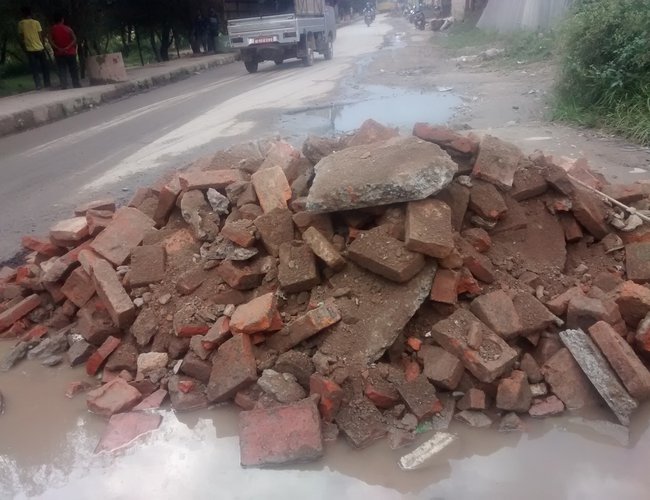
Waste dumped at the road
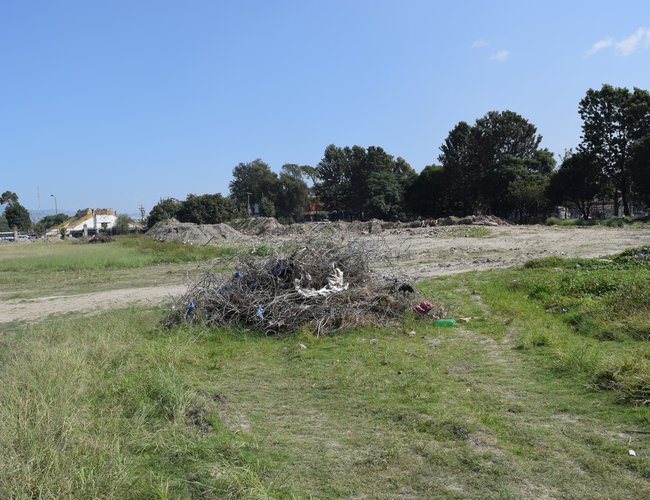
Earthquake wasted piled up in Tundikhel
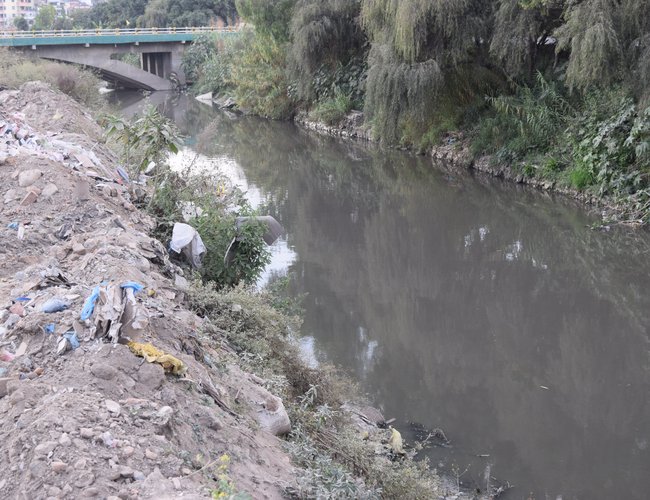
Waste dumped at the bank of Manahara river
- TANAHU HYDROPOWER PROEJCT: A Significant Achievement
- Apr 15, 2024
- AMBASSADOR HANAN GODAR: Sharing Pain With A Nepali Family
- Mar 30, 2024
- VISIT OF KfW AND EIB TO NEPAL : Mission Matters
- Mar 25, 2024
- NEPAL BRITAIN SOCIETY: Pratima Pande's Leadership
- Mar 24, 2024
- NEPAL ARMY DAY: Time To Recall Glory
- Mar 15, 2024

